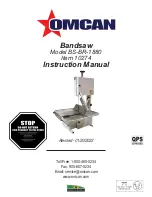
www.scheppach.com
GB | 37
k) Always keep saw blades clean, sharp and suf-
ficiently set. Never use warped saw blades or
saw blades with cracked or broken teeth.
Sharp and correctly set saw blades minimise jam-
ming, blocking and kickback.
Safety instructions for the operation of circular
table saws
a)
Switch off the circular table saw and discon
-
nect it from the power supply before removing
the table insert, changing the saw blade, im-
plementing settings on the riving knife or the
saw blade protective cover, and if the machine
is left unattended.
Precautionary measures serve to prevent acci-
dents.
b) Never leave the circular table saw running
unattended. Switch off the electric tool and
do not leave it until it has come to a complete
standstill.
An unattended running saw poses an uncontrolled
risk.
c) Set up the circular table saw in a location that
is level and well ventilated, and where it can
stand safely and remain balanced. The instal-
lation site must provide sufficient space for
easily handling the size of your workpieces.
Disorganised and unlit working areas, and uneven,
slippery floors may lead to accidents.
d) Regularly remove chips and sawdust from be-
neath the saw table and/or from the dust ex-
traction system.
Accumulated sawdust is flammable and can
self-ignite.
e) Secure the circular table saw.
If a circular table saw is not secured correctly, it
can move or topple.
f) Remove the adjustment tools, wood residues,
etc. from the circular table saw before switch-
ing it on.
Deflections and possible jams could be danger
-
ous.
g) Always use the right size of saw blade
and an appropriate location hole (e.g. dia-
mond-shaped or round).
Saw blades that do not fit with the mounting parts
of the saw will run out-of-centre and result in a loss
of control.
a) Never stand directly in line with the saw blade.
Always stand at the side of the saw blade on
which the stop rail is located.
With kickback, the workpiece may be thrust at high
speed towards those persons who stand in front
of, or in line with the saw blade.
b) Never reach over or behind the saw blade to
pull or support the workpiece.
This can result in accidental contact with the saw
blade, or kickback can lead to your fingers being
drawn into the saw blade.
c) Never hold and push the workpiece against the
turning saw blade during sawing.
Pushing the workpiece against the saw blade dur-
ing sawing will lead to jamming and kickback.
d) Align the stop rail parallel to the saw blade.
A stop rail that is not aligned will push the work-
piece against the saw blade and create kickback.
e) With concealed saw cuts (e.g. folds, grooves
or slits in the turning process), use a thrust
collar to guide the workpiece against the table
and stop rail.
Using a thrust collar, you are able to better control
the workpiece in the event of kickback.
f) Apply particular caution when sawing assem-
bled workpieces in areas that are not visible.
The plunging saw blade can saw into objects that
could cause a kickback.
g) Support large panels, in order to avoid the risk
of kickback due to a jammed saw blade.
Large panels may bend under their own weight.
Panels must be supported in all areas where they
overhang the table surface.
h) Apply particular caution when sawing work-
pieces that are twisted, knotted or warped, or
that do not have a straight edge that can be
used to guide them with a mitre stop or along
a stop rail.
A twisted, knotted or warped workpiece is unsta-
ble and results in incorrect alignment of the kerf
with the saw blade, jamming and kickback.
i) Never saw multiple workpieces stacked on top
of each other, or one behind the other.
The saw blade could engage in one or more parts
and result in kickback.
j) If you wish to restart a saw, the saw blade of
which is inserted in a workpiece, centre the
saw blade in the sawing gap so that the saw
teeth are not hooked in the workpiece.
If the
saw blade is jammed, it can lift the workpiece and
cause kickback when the saw is restarted.
















































